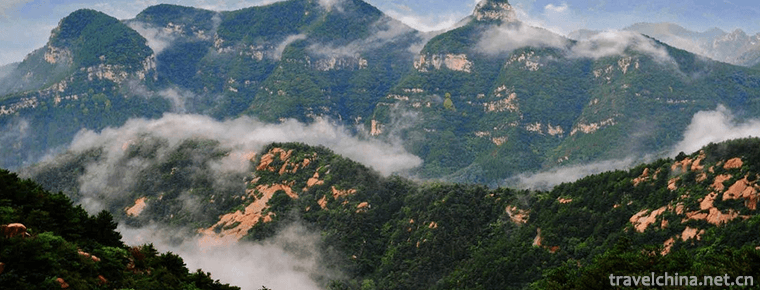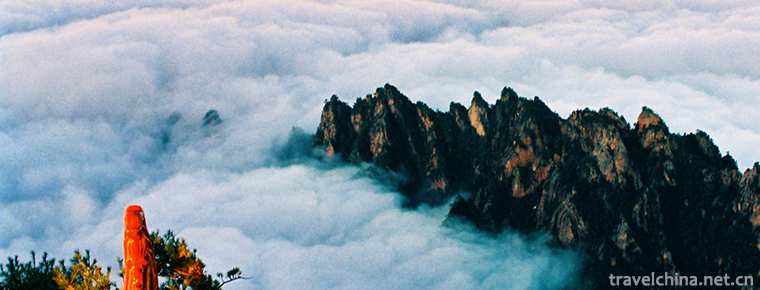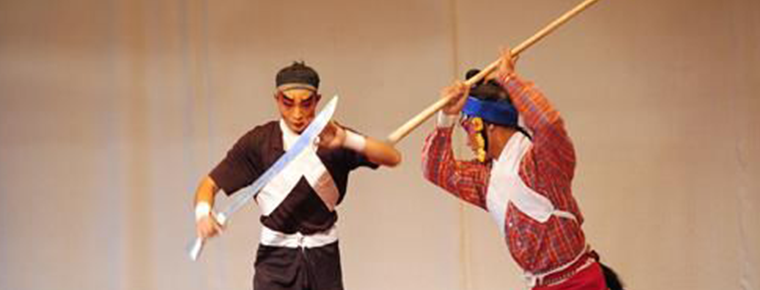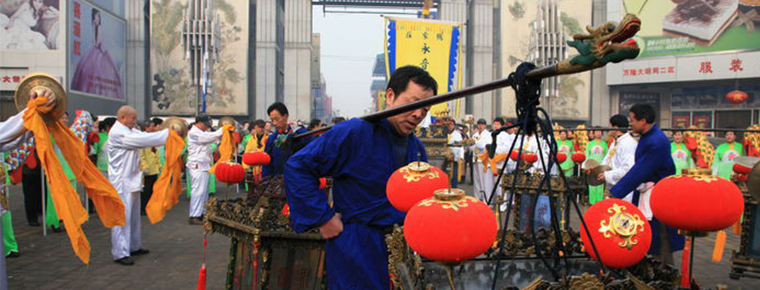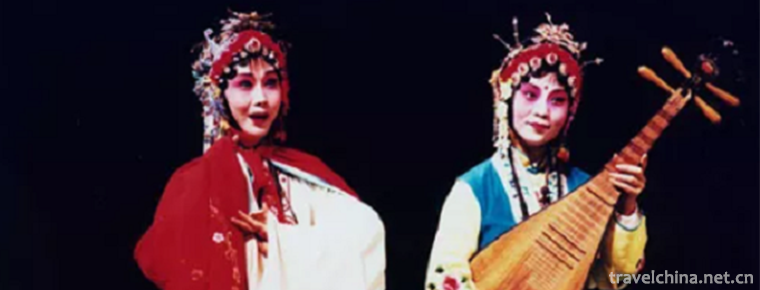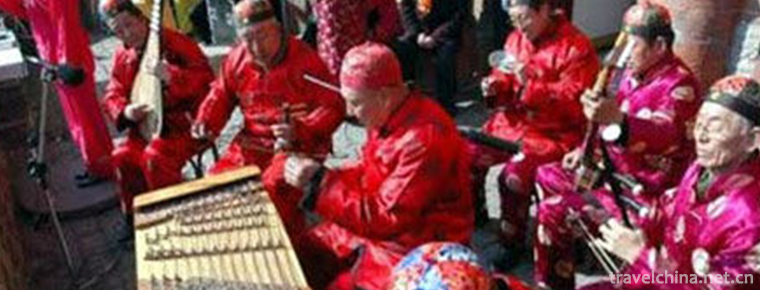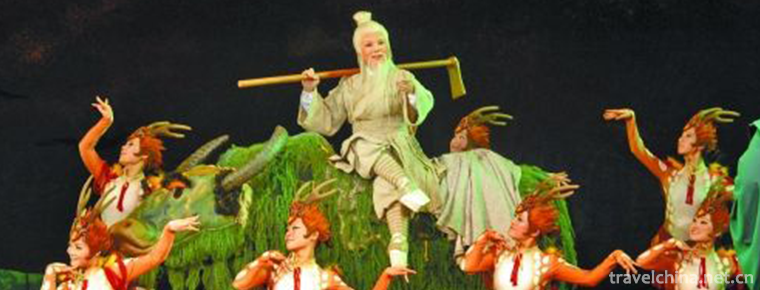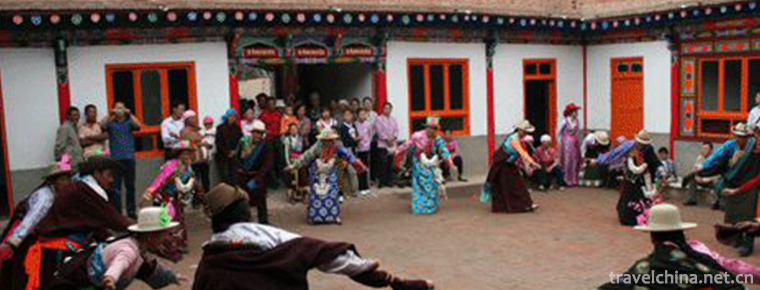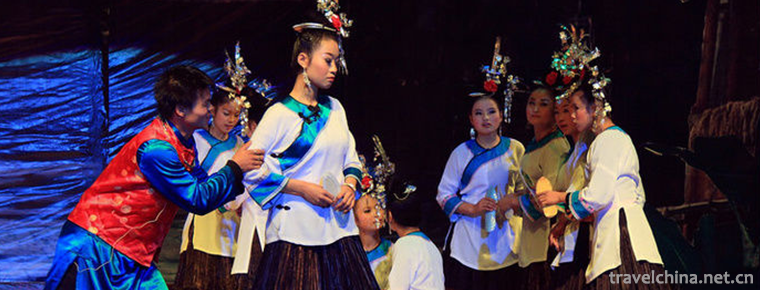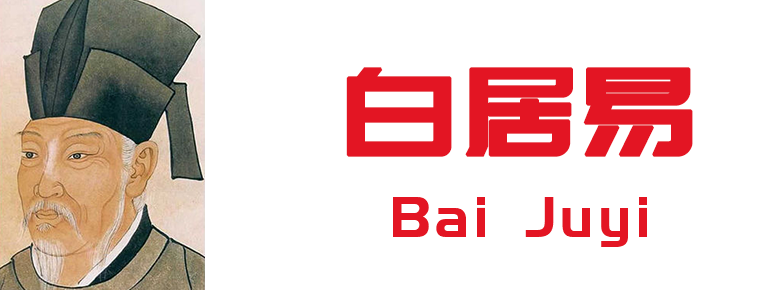Shu embroidery
Shu embroidery
Shu Embroidery, a special product of Chengdu City, Sichuan Province, is a product of China's National Geographic Indicators.
Shu embroidery, also known as Sichuan embroidery, is as famous as Su embroidery, Hunan embroidery and Guangdong embroidery. It is one of the four famous embroidery in China. It is a traditional Chinese craft that uses silk thread to embroider patterns on silk or other fabrics. As one of the longest-inherited embroidery species in China, Shu embroidery has formed its own unique charm with its bright and beautiful color and exquisite needling, ranking first among the four famous embroidery in richness.
Shu embroidery has a long history, which can be traced back to Sanxingdui civilization. Since the Eastern Jin Dynasty, Shu brocade has been called "treasure in Shu". Shu embroidery is mainly made of soft satin and coloured silk. There are 122 kinds of needling methods in 12 categories. It has the characteristics of rigorous needling, even needle feet, rich variety, vivid image and stereoscopic feeling.
On December 03, 2012, the former General Administration of Quality Supervision and Inspection approved the implementation of the protection of geographical indication products for "Shu embroidery".
Product characteristics
Quality characteristics
The Shu embroidery originated from the folk in Western Sichuan has gradually formed a unique style of rigorous and delicate, bright and smooth, clear composition, rich and mellow, and bright color due to the influence of geographical environment, customs, culture and art, etc.
Technological characteristics
Shu embroidery is the first of the four famous embroidery techniques.
Shu embroidery is one of the four famous embroidery in China because of its skilled craftsmanship and delicate lines. In its long history of development, Shu embroidery has gradually formed the characteristics of rigorous needling, bright patches, even stitches and bright colors. Shu embroidery is embroidered on local silk and satin with various dispersive threads (looser silk threads) or silk threads (thinner and tighter silk threads) dyed in Chengdu area. Because of careful material selection and production, strong workmanship, solid material and low price, the finished product has been sold in Shaanxi, Shanxi, Gansu, Qinghai and other provinces for a long time, and is very popular.
According to statistics, there are 12 categories of Shu embroidery needles, more than 130 kinds, which are the most abundant of the four famous embroidery, and more than 70 Daoyi brocade thread is unique to Shu embroidery. Commonly used needling methods include halo needle, laying needle, rolling needle, cutting needle, mixing needle, sand needle, cover needle, etc. Pay attention to "needle feet are neat, thread is bright, compact and soft, the car is screwed to home". Various needling methods are used interlacedly, changing from end to end, or alternating in thickness, or combining virtual with real, and Yin and Yang are manifested far and near. These traditional techniques are not only good at embroidering flowers, birds, insects, fish and other exquisite crafts, but also good at expressing the magnificent landscape, portraying the image of the characters and lifelike. Since liberation, there have been some innovations in needle embroidery techniques, such as "cross needle" for expressing the texture of animal fur, "spiral needle" for expressing people's hair buns, and "covering needle" for carp scales, which have greatly enriched the manifestation and artistic style of Shu embroidery.
Shu embroidery is flexible and adaptable. Generally, silk, satin, silk, yarn and crepe are used as fabrics for embroidery. According to the needs of embroidery, the production procedures, color matching and thread use are different. Shu embroidery often uses halo needle to express the texture of embroidery, embody the light, color and shape of embroidery, and make embroidery vivid. Such as the agility of carp, the agility of golden monkey, the beauty of characters, the magnificence of mountains and rivers, the variety of flowers and birds, the naivety of pandas and so on. It also uses "line embroidery" to use halo, yarn, rolling, hiding and cutting techniques on white soft satin fabrics. It uses needle instead of pen and thread as ink. The embroidered patterns are smooth and soft in tone. It not only adds the wet feeling of the pen and ink, but also has a smooth and transparent texture.
Subject matter of works
The subjects of Shu embroidery are mostly flowers and birds, animals, mountains and rivers, insects and fish, and figures. Apart from the powdered versions of ancient famous paintings such as the grotesque stones of Su Dongpo, the bamboo stones of Zheng Banqiao and the characters of Chen Laolian, the famous painters at that time were asked to design embroidery manuscripts, which were processed and recreated by embroidery craftsmen. Popular embroidery patterns include landscapes, flowers and birds, Bogu, dragons and phoenixes, Wawen and ancient money, as well as folk legends, such as Eight Immortals crossing the sea, Ma Gu offering their lives, blowing choices and attracting phoenixes, Kirin delivering their children, etc. There are also magpies, bustling plums, ducks and playful water, Jinyu Mantang, Fengchuan peony and so on, which are rich in local characteristics, such as lotus carp, bamboo horse chicken, mountain panda, etc. Flowers and birds are also favored by the East and the West.
Origin Environment
Shu embroidery mainly refers to the embroidery in the western Sichuan plain centered around Chengdu, Sichuan. Because of its cultural and geographical origins, it has also developed to the surrounding areas such as Chongqing. From the perspective of modern science, the Chengdu Plain is rich in soil and water, pleasant climate, temperature and humidity are suitable for mulberry planting and silkworm rearing. This area in Western Sichuan was known as "Shu" in ancient times and abounds in silk on the land of Bashu. The silk civilization of ancient Shu gave birth to developed silk weaving technology, which not only provided embroidery raw materials for Shu embroidery - silk and silk thread, but also provided a solid material basis for the development of Shu embroidery, and created an industrial and cultural environment for the prosperity of Shu embroidery.
historical origin
The development of Shu embroidery is based on the rich land of Shu, especially the high quality and large quantity of silk and silk produced. The Western Han Dynasty writer Yang Xiong's "Shudu Fu" said, "Brocade embroidery looks like a beautiful cloth, but there is no room for it." He also described the scenes of "brachial brocade" and "silk embroidery" everywhere in Chengdu. In addition, Yang Xiong's "Embroidery Supplement" poem expresses the author's high praise for Shu embroidery skills. At the end of the Western Han Dynasty, Shudi was "the career of women workers, covering the world" (The Book of the Later Han Dynasty). According to documents, the earliest monarch silkworm clump in Shu Kingdom of Eastern Han Dynasty has learned to breed silkworm. At the end of the Han Dynasty and the Three Kingdoms, Shu brocade and Shu embroidery were well-known all over the world. As a rare and expensive silk fabric, Shu often used it to exchange warhorses or other materials from the north. Jin Changbi's Hua Yang Guo Zhi detailedly contains the treasures of Shu land, so it ranks the rich brocade with gold, silver, pearls and jade.
At the end of Tang Dynasty, Nanzhao attacked Chengdu, plundering not only gold and silver, Shu brocade and Shu embroidery, but also a large number of Shu brocade and Shu embroidery craftsmen, which were regarded as exotic objects. According to the Records of Yuanhe Prefectures and Counties, Anjing embroidery entered the court as a tribute in the Tang Dynasty and became the main object for the emperor to reward meritorious officials. During the Five Dynasties and Ten Kingdoms Period, the relatively stable situation in Sichuan created favorable conditions for the development of Shu embroidery. The increasing social demand stimulated the rapid development of Shu embroidery industry.
In the Song Dynasty, the name of Shu embroidery had spread all over Shenzhou. Literature said that Shu embroidery technique was "extremely skillful in poor work". The development of Shu embroidery reached its peak. Embroidery products were unique in technology, production and sales, and exquisite degree.
After the mid-Qing Dynasty, Shu embroidery gradually formed an industry. During the Daoguang period, the three emperors and gods Association of non-governmental organizations was established. This is a special guild of embroidery industry consisting of shop, material and division. The formal implementation of the vertical version, the establishment of rules and regulations, the determination of professional division of labor, and the maintenance of the interests of all parties within the industry show that Shu embroidery has gradually entered the market from the family, forming a large-scale production that is widely needed by society. In order to promote the revitalization of industry, the government at that time set up "Advising Bureau" to encourage Shu embroidery production. Advising the Bureau of Industry to set up an embroidery department, which specializes in the production and sale of Shu embroidery. Many fine works of Shu embroidery have been designated as Royal tribute, and outstanding artists have been awarded the title of "five tastes and the same title", which greatly encourages the production and production of Shu embroidery. With the establishment of Shu Embroidery Association, there are dozens of Shu Embroidery shops and workshops in Chengdu, and more than 1000 embroidery workers are employed. During this period, embroidery products began to be designed by professional designers. The products were gradually divided into three industries: clothing, costume and lighting.
From the end of the Qing Dynasty to the beginning of the Republic of China, Shu embroidery enjoyed a high reputation in the world and won the gold medal in the Panama International Competition in 1915. After the Republic of China, although Shu embroidery no longer embroidered court clothes and tributes, the scope of embroidery of daily necessities has become wider and wider, covering almost all aspects of people's daily life. From young children's clothes, shoes and hats to bedding, interior decorations and gifts for marriage. This is the outstanding folk aspect of Shu embroidery. Urban and rural women often embroider shoes, caps, pillows, headscarves, even curtains and quilts in their leisure time. Those who practice very well become masters.
During the Anti-Japanese War, the cultural center moved southward. Many artists and craftsmen came to Chengdu and made positive contributions to the development of Shu embroidery.
After the founding of New China, Chengdu Shu Embroidery Factory was set up in Sichuan, which made the development of Shu embroidery technology enter a new stage and continuously innovate in technology. Such as the "cross needle" which expresses the texture of animal fur, the "spiral needle" which expresses the character's hair bun, and the "covering needle" which expresses carp scales, greatly enrich the expression form and artistic style of Shu embroidery. During the Cultural Revolution, Shu embroidery and many excellent national cultural heritages were criticized as "seal, capital and repair". Artists engaged in embroidery were even accused of "serving emperors and generals, gifted scholars and beautiful women". As a result, the embroidery industry changed production and embroidery workers changed their ways to make a living.
During the turmoil, Shu Embroidery Factory was affected by the outside world, some important materials were destroyed, and many people were affected to varying degrees. This situation lasted until 1972, before and after the Canton Fair. At that time, the four major embroidery in China, Guangdong embroidery, Su embroidery and Hunan embroidery, all participated in the Canton Fair, but there was no Shu embroidery. President Nixon also asked Premier Zhou Enlai about the situation of Shu embroidery. After that, government leaders began to pay more attention to it. Shu embroidery factory waited for a new turning point.
At the end of 1970s, the countryside in Western Sichuan was almost a household needle worker with a population of 45,000, which was 15 times the number of employees in embroidery factories. In addition to dozens of varieties such as embroidered quilt, pillowcase, headscarf, handkerchief, shirt and table cloth, they also actively produce raw textile embroidery pieces and embroidered screen for export. Embroidery still maintains strong local characteristics.
After 1981, Shu embroidery has made great progress. Apart from the workers specializing in embroidery in Shu embroidery factory, the number of people processing embroidery in rural suburbs and counties has rapidly increased to 7,000 and 8,000.
Shu embroidery won high honors in 1982, the second Hundred Flowers Award for Chinese arts and crafts, and the Paris Expo in 1985.
Product Honor
In 1915, Shu Embroidery won the Panama International Gold Prize in the International Panama Competition.
In 1982, Shu Embroidery was awarded the silver cup of the Hundred Flowers Award for Chinese Arts and Crafts.
On May 20, 2006, Sichuan embroidery in Chengdu City was approved by the State Council and listed in the first batch of national intangible cultural heritage list.
In 2008, Shu Embroidery in Chongqing Yuzhong District was selected as the first batch of national intangible cultural heritage expansion projects.
geographical indication
Scope of geographical protection
The origin of Shu embroidery is in Chengdu, Sichuan Province.
Quality Technical Requirements
I. Quality Requirements for Raw Materials
1. Quality requirements of silk yarn: silk yarn is dyed by traditional process, fixed with local rapeseed oil, and then split into 1/2, 1/4, 1/8, 1/16 or even finer according to different patterns. The quality of embroidery thread shall conform to the relevant product standards.
2. Material quality requirements: high-quality silk soft satin, soft white canvas, Shu brocade, etc., can meet the relevant performance requirements of embroidery and mounting, and meet the national quality and technical requirements.
II. Screen Requirements
1. Embroidery pattern: healthy and aesthetic.
2. Legitimate designs that may not infringe upon the intellectual property rights of others.
3. Embroidery: Painting, photography, calligraphy and other works of art. Mainly for animal material, plant material, character story material, natural material, building material, utensils material, text material, geometry material and so on.
4. Commodity embroidery accounts for not less than 40% of the main expression of embroidery.
III. Process Requirements
It is produced by pure manual traditional process design, sketching, tensioning, wiring, embroidery, mounting (after sewing, etc.) and inspection.
IV. Needling Requirements
122 kinds of needling methods were used in Shu embroidery tradition. There are twelve types of stitches, including stitches for points and lines, stitches for embroidery plane, stitches for blending colors and colors, stitches for turning, covering, winding, stitching, stitching, stitching, supplementary and brocade stitches.
1. Embroidery points and lines: To form ideas with very fine lines, often used for embellishing patterns such as stamens embroidery.
2. Embroidery plane type: embroidery plane with laying needle, covering needle, reference needle, halo needle and other needle methods.
3. Blending color and color category: refers to the embroidery method of blending another color into one color's embroidery surface to form a color transition.
4. Turning needle type: It is a kind of needle method that expresses the bending shape of circle, curve and surface by means of "turning" and "turning" needle transport.
5. Covering needles: embroidery method used to embroider people's faces and hands to show skin halo.
6. Wrapping needles: It is an embroidery method in which needles and threads are wound and knotted into embroidery.
7. Nail line type: refers to the embroidery method of using thicker embroidery thread to disk patterns on the cloth surface, and using short flat needle to fix them vertically with thin thread.
8. Stitching: refers to the stitching applied to other stitches, which is commonly used in high-grade decorative embroidery.
9. Scale armor embroidery: It is the needle method of embroidering scales and feathers.
10. Tie-up needle: It is used to consolidate embroidery.
11. Supplementary embroidery: It is an embroidery method to sew the embroidered pieces on the base cloth.
12. Brocade needle: It refers to an embroidery method which imitates the pattern of brocade and the texture of yarn to express the pattern.
All kinds of needling methods should be applied according to the requirements of the picture. The needle feet are neat, the thread is bright, compact and soft, and the car is screwed to the home.
V. Post-processing requirements
1. Handicraft mounting:
(1) Soft mounting: The embroidery pieces are mounted with silk brocade, with clear patterns, good texture, no bubbles, no shelling, continuous cracking, accurate angle, straight threads, regular patterns and neat whole.
(2) Hard mounting: Stick the embroidery piece on the floor or glass. When mounting, it should be decontaminated and clear. The embroidery surface is flat, neat, no paste and no dirty spots. The frame and frame specifications are correct. The paint is bright and the wood surface is free of scars and spots.
2. After-processing of daily necessities: after-processing of embroidery pieces or embroidery products by sewing, ironing and other methods, and meeting the quality requirements of related textiles.
VI. Quality Characteristics
1. The silk thread used in the product is rich and delicate in luster, full and lasting in color, and has toughness. The silk with embroidered bottom is light and not deformed, and it is not easy to break down. The embroidery design is elegant, meticulous, soft and lustrous with silk thread. The embroidery works have neat stitches, bright threads, compact and soft, and the car is twisted to the home. They are spiritual and non-rigid, which is different from machine embroidery. The works have the characteristics of non-decaying, non-decaying and non-fading.
2. Safety and other quality technical requirements: The product safety and other quality technical requirements must conform to the relevant national regulations.

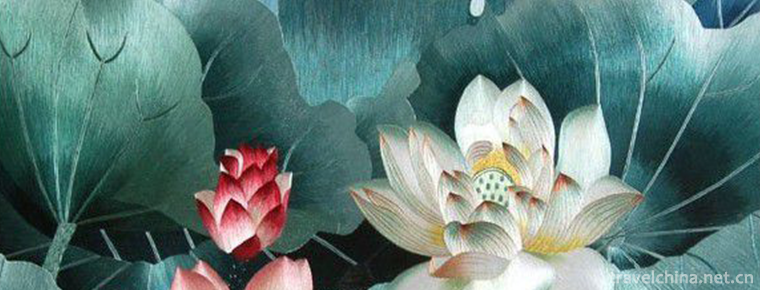
-
Yimeng Mountain Range
Yimeng Mountain Tourist Area is a cross-regional tourism area consisting of the geographical coordinates of Mengshan and Yishan Mountains according to the local tourism department of Shandong Province.
Views: 118 Time 2018-12-08 -
Old boundary ridge of Funiu Mountain
Laojieling is located in the north of Xixia County, Nanyang City, Henan Province. It is located in the upper part of the south slope of Funiu Mountain.
Views: 131 Time 2018-12-09 -
Da Xian Opera
Daxian opera is a local traditional drama in Huaxian and Puyang counties of Henan Province, and one of the intangible cultural heritage at the national level. The singing music of Daxian opera belongs.
Views: 198 Time 2019-04-23 -
Dong Pipa Song
Dong Pipa song is distributed in the southern dialect area of Dong nationality, which can be divided into lyric and narrative Pipa song. Its singing content almost covers Dong history.
Views: 118 Time 2019-04-28 -
Jin men drum
Jinmen Fagu is a local traditional music and dance art in Tianjin, which appears in the form of performances of the Lao Hui or the Sacred Congregation. In June 2008,.
Views: 137 Time 2019-05-07 -
Soviet Opera
Su Opera is a combination of Huagu Tanhuang, Nanci and Kunqu Opera. It is popular in the urban and rural areas of southern Jiangsu and Northern Zhejiang. Its predecessor, Sutan, was originally called .
Views: 72 Time 2019-06-16 -
Yulin Xiaoqu
The lyrics of Yulin Xiaoqu are integrated with elegance and vulgarity. In terms of language style and structure, there are not only words used by ordinary scholars, but also local dialects and dialect.
Views: 165 Time 2019-07-14 -
Extra tune
In addition to the form of opera, Yue Diao has two branches, namely, opera and puppet. In 1942, there was a severe drought in Henan Province. During this period, many cross-tone artists (such as Zhang.
Views: 263 Time 2019-07-16 -
Zerou
Zerou (Shangyu Zerou), also known as Ashze, is a Tibetan folk dance in Guide County, Qinghai Province. Especially "Shangyu (Chinese: lower row) is soft" is the most important. They often per.
Views: 439 Time 2019-07-16 -
Zhulang Niangmei
Zhulang Niangmei is a work of Dong Opera in Guizhou Province. At the end of the Qing Dynasty, Liang Yaoting and Liang Shaohua, Dong opera masters in Congjiang County, Guizhou Province, adapted Dong dr.
Views: 140 Time 2019-08-10 -
Bai Juyi
Bai Juyi (772 - to - 6), Le Tian, the number of Xiangshan residence, and Mr. drunken Yin, whose ancestral home is Taiyuan, Shanxi. And moved to his great grandfather. Lower jaw Born in Henan Xinzheng .
Views: 249 Time 2019-09-06 -
Suining famous specialty
Suining City has Shehong Medina beef, Daying white lemon, Chuanshan bean curd peel, Anju golden pear, zhuotang well salt, da'anshu beef, Chicheng lake fish mat, shehongyexiang pig, Anju 524 sweet potato, Pengxi green pepper, Pengxi Xiantao, qiaoguanying .
Views: 331 Time 2020-12-16
